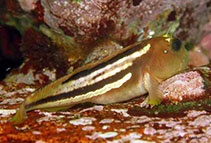| Family: |
Blenniidae (Combtooth blennies), subfamily: Salariinae |
| Max. size: |
19.7 cm SL (male/unsexed) |
| Environment: |
demersal; marine; depth range 0 - 10 m |
| Distribution: |
Southeast Pacific: Independencia Bay, Peru to Valparaiso, Chile. |
| Diagnosis: |
Dorsal spines (total): 12; Dorsal soft rays (total): 17-19; Anal spines: 2; Anal soft rays: 19-20. Distinctive in having a relatively uniformly pigmented body without spots; further differentiated from S. gigas and S. variolatus in having a high number of dentary teeth, 106-131 (versus 93 or fewer). |
| Biology: |
Adults are found in tide pools and rocky shore areas. Are primarily herbivorous (Ref. 9032). Selectively feed on the green algae Ulva, Enteromorpha, as juveniles and favor red algae Gelidium as adults (Ref. 94105). Oviparous. Eggs are demersal and adhesive (Ref. 205), and are attached to the substrate via a filamentous, adhesive pad or pedestal (Ref. 94114). Larvae are planktonic, often found in shallow, coastal waters (Ref. 94114). |
| IUCN Red List Status: |
Least Concern (LC); Date assessed: 27 March 2009 Ref. (130435)
|
| Threat to humans: |
harmless |
Source and more info: www.fishbase.org. For personal, classroom, and other internal use only. Not for publication.
